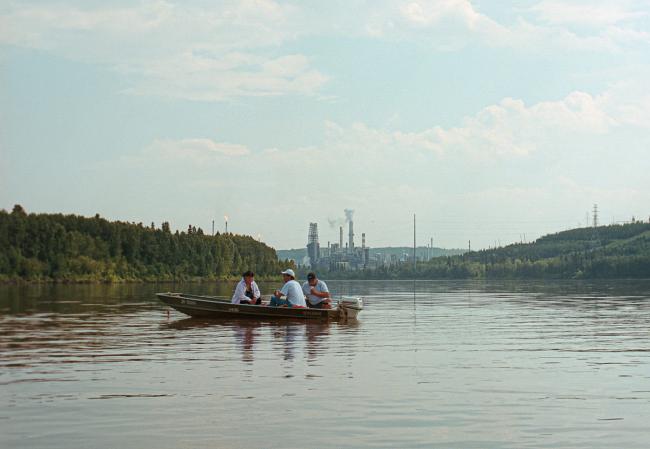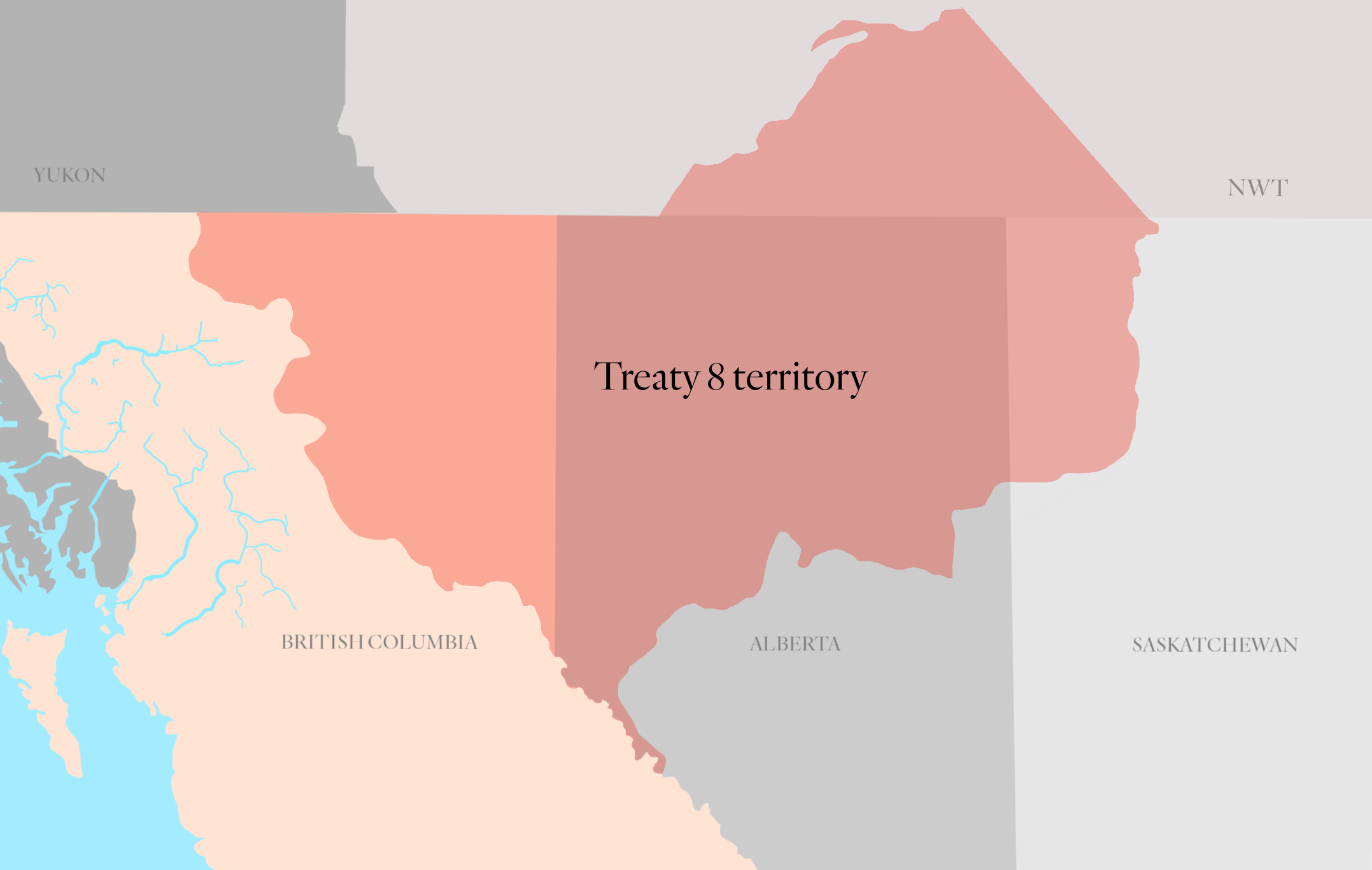Articles Menu

May 28, 2020
When Woodland Cree Chiefs met with commissioners of the Crown at Lesser Slave Lake in June 1899 to sign Treaty 8, it’s likely no one completely understood the full scale of industrial development that lay ahead.
Alberta was a half-century away from the major oil strike that would set Canada on the path to becoming the world’s fifth-largest oil producer. Back then dams in British Columbia were built by beavers, not BC Hydro, and the Peace River flowed freely from the Rockies all the way to the Athabasca delta.
The document, subsequently signed by Dunneza and Chipewyan Chiefs, would govern relations between Indigenous peoples and the Crown over the largest tract of land in Canada covered by a single treaty — a landmass larger than France.
One hundred and twenty years later, oilsands pits, sprawling tailings ponds, clearcuts slicing through the boreal forest, fracked oil and natural gas wells, pipelines, seismic lines, dams and a massive hydro-electric reservoir filled with mercury-contaminated fish have turned much of that landscape into one giant industrial sacrifice zone.
The “cumulative effects” of such disturbances lie at the heart of a recent important judgment handed down by the highest court in Alberta. It’s a decision that lawyers representing First Nations in proceedings before the courts in British Columbia say may have positive implications for their clients as they fight the ongoing loss of their rights on treaty lands.

A map of Treaty 8 territory. Map: Carol Linnitt / The Narwhal
The Alberta Court of Appeal’s decision in late April marks a major victory for Fort McKay First Nation, which had tried for decades to protect the Moose Lake area north of Fort McMurray.
In 2015, Chief Jim Boucher and other members of the nation were promised by former Alberta premier Jim Prentice that the government would help them develop an access management plan for the critical area that would limit industrial activity near the lake and within traditional harvesting areas.
“When Chief Boucher asked for our support to protect the small parcel of land near Moose Lake for his community, I didn’t hesitate to say yes,” Prentice said in a government press release at the time.
But the promised management plan never materialized. In 2018, the Alberta Energy Regulator approved an application by Prosper Petroleum Ltd. for a 10,000-barrel-a-day oilsands project adjacent to Moose Lake, propelling the nation into the courts.
A historically willing participant in oilsands operations, the Fort McKay First Nation is taking the Alberta government to court over its failure to protect Moose Lake, a sacred site, from rampant industrial development
The three Appeal Court justices concluded the regulator failed to properly consider the public interest and “that there was no basis” for the regulator “to decline to consider” the promised planning process.
“Due to the extensive industrial and resource development surrounding Fort McKay, [the Fort McKay First Nation] is concerned that the ability of its members to pursue their traditional way of life in the Moose Lake Area has been severely and adversely affected by the cumulative effect of oilsands development … 70 per cent of [the Fort McKay First Nation’s] traditional territory is leased for oilsands purposes,” the justices noted in their judgement.
The justices quashed the regulator’s approval of the project and ordered it to “reconsider” whether the project was in the broader public interest and the project’s impacts on Indigenous peoples.
In a concurring judgement, Justice Sheila Greckol took the added step of telling the provincial regulator what was required to uphold the honour of the Crown. Greckol noted the Alberta government knew the nation objected to “consultation” on a project-by-project basis because doing so meant the “cumulative effects of development” were never addressed.
“That is not honourable. And it is not reconciliation.”
“The honour of the Crown may not mandate that the parties agree to any one particular settlement, but it does require that the Crown keep promises made during negotiations to protect Treaty Rights,” Justice Greckol wrote, adding “the honour of the Crown has as its ultimate purpose the reconciliation of Aboriginal interests with Crown sovereignty” and seeks to prevent Aboriginal Rights from turning into an “empty shell.”
“It certainly demands more than allowing the Crown to placate [the Fort McKay First Nation] while its Treaty Rights careen into obliteration,” the justice wrote. “That is not honourable. And it is not reconciliation.”
Maegen Giltrow, a Vancouver-based lawyer representing the Blueberry River First Nation in a case in which the nation seeks to stop the British Columbia government from approving industrial development that “unjustifiably infringes their Treaty Rights,” said the judgement is highly relevant to the Blueberry case.
“The last paragraph of the judgement is actually so telling,” Giltrow told The Narwhal. “The obligation to implement the treaty is far more than an obligation just to consult. It’s not just sort of talking pleasantly while you continue to approve.”
Giltrow added the finding is “obviously true across all provinces” where Treaty 8 applies.
In the Blueberry River First Nation’s case, three quarters of the nation’s traditional lands now lie within 250 metres of an industrial disturbance, and opportunities for the nation’s members to carry out their Treaty Rights to hunt, fish and trap have plummeted.
Only a few witnesses remain before lawyers representing both sides give their closing arguments, which are expected to last a month. A decision by the court may be a year or more away.
Blueberry River and the death by a thousand cuts
Once promised a life in perpetuity on a rich and vibrant landscape, the Blueberry River First Nations have brought B.C. to court to face the cumulative impacts of rampant oil, gas and forestry that has left the land degraded, wildlife poisoned and Treaty 8 in tatters. If successful, the case has the power to transform the way First Nations, industry and governments plan and execute resource projects across Canada
Tim Thielman, a lawyer representing the West Moberly First Nations in another matter before the B.C. Supreme Court involving the provincial government and cumulative impacts, also said the Alberta Court of Appeal decision may apply in B.C.
Thielman said the Alberta case “could be a positive sign for other First Nations that are seeking remedies for … multiple Crown projects in their territories.”
The most significant industrial project underway in West Moberly First Nation territory right now is the Site C dam. The project will flood more than 120 kilometres of the Peace River valley and tributary valleys, on top of the extensive flooding caused by the W.A.C. Bennett and Peace Canyon dams upstream of Site C.
The impact that just one dam would have on treaty lands was probably never considered at the time Treaty 8 was signed, let alone the potential impact of three dams on the Peace River.
“That cumulative effect was never contemplated by the parties that entered the treaty,” Thielman told The Narwhal.
“At the time, they had in mind some small-scale mining and logging, and guys working with pickaxes — not entire ecosystems being radically transformed and irreversibly submerged.”
Jack Woodward, who along with Joseph Arvay represented the Fort McKay First Nation before Alberta’s highest court, also represented the Treaty 8 Tribal Association before the Supreme Court of Canada in 2005’s landmark Mikisew Cree case.
The case involved a winter road the federal government first intended to run right through a Mikisew Cree First Nation reserve. The federal government later rerouted the proposed road to skirt around the edge of the reserve. The nation wasn’t consulted in either case.
Central to that case was the tension inherent in the two main provisions of the treaty: the right of the First Nations to hunt, fish and trap, and the right of the Crown to “take up” land for settlements and other purposes.
What the court decided in that case, Woodward said, was that there must be “meaningful” opportunities to hunt, fish and trap.
“It took until 2005 for Canadian law to work out what those two conflicting objectives of the treaty are,” Woodward told The Narwhal. “Obviously there’s a point where those two things clash. If you take up every square inch of the land, then there’s no more right to hunt, fish and trap.”
“It becomes an ecological question,” Woodward continued.
“The ecological question is how much habitat must be preserved in order to provide a meaningful opportunity to hunt, fish and trap. And … a meaningful right to hunt, fish and trap must mean that there is a perpetual, harvestable surplus of a necessary species in sufficient abundance to satisfy the need. So if you’re talking about moose, how big does the herd of moose have to be in order to support an annual harvest necessary to create a meaningful hunt for that First Nation?”
Increasingly, members of the Fort McKay, Mikisew Cree, West Moberly and Blueberry River First Nations appear to have the same answer to that question: “A heck of a lot more than we’ve got right now.”
[Top photo: Fort McKay First Nation member Michael Bouchier, middle, takes his friends on a boat ride toward a Suncor Energy operation on the Athabasca River. The Fort McKay recently won a legal battle against a new oilsands project near Moose Lake. Photo: Aaron Vincent Elkaim]